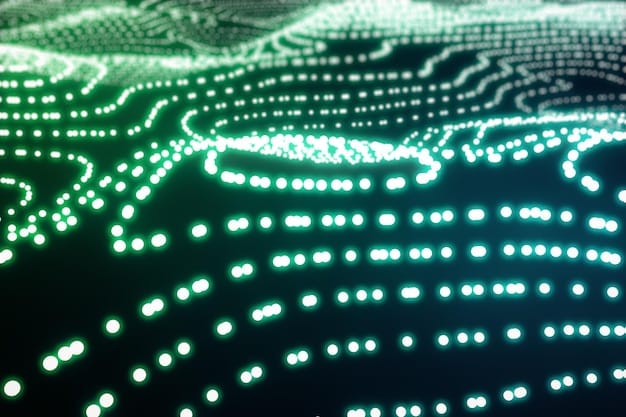Quantum Computing’s Impact on US Cybersecurity: Encryption Risks & Solutions

US Cybersecurity News: The Impact of Quantum Computing on Encryption highlights the urgent need to address vulnerabilities in current encryption methods as quantum computers advance, threatening data security across various sectors.
The rapid advancement of quantum computing poses a significant threat to current encryption methods, impacting US cybersecurity and demanding proactive solutions. US Cybersecurity News: The Impact of Quantum Computing on Encryption is becoming an increasingly critical area of concern for both government and private sector organizations.
Quantum Computing: A Paradigm Shift in Cybersecurity
Quantum computing, with its potential for unparalleled processing power, is poised to revolutionize numerous fields. However, its impact on cybersecurity, particularly encryption, presents a complex challenge that the US needs to address proactively.
Traditional encryption methods, which have long been the cornerstone of data protection, rely on mathematical problems that are difficult for classical computers to solve. Quantum computers, leveraging the principles of quantum mechanics, can potentially crack these codes much more efficiently.

The Vulnerability of Current Encryption
Most of today’s encryption algorithms, such as RSA and ECC, are based on the difficulty of factoring large numbers or solving elliptic curve problems. Quantum computers, utilizing algorithms like Shor’s algorithm, could solve these problems in polynomial time, rendering current encryption obsolete.
- Shor’s Algorithm: A quantum algorithm that can factor large numbers exponentially faster than the best-known classical algorithm.
- RSA Encryption: A widely used public-key cryptosystem that relies on the difficulty of factoring the product of two large prime numbers.
- ECC (Elliptic Curve Cryptography): Another public-key cryptosystem that is vulnerable to quantum attacks, though potentially less so than RSA.
The implications are far-reaching, impacting everything from financial transactions and healthcare records to national security and critical infrastructure. The vulnerability of these systems to quantum attacks is a serious concern that demands immediate attention and action.
In conclusion, the advent of quantum computing introduces a new era in cybersecurity, necessitating a reassessment and strengthening of current encryption practices. The vulnerability of existing algorithms means that the U.S. must invest in quantum-resistant cryptography to protect its data assets.
Quantum-Resistant Cryptography: Securing the Future
To mitigate the threat posed by quantum computers, researchers are developing quantum-resistant cryptographic algorithms, also known as post-quantum cryptography (PQC). These algorithms are designed to be secure against both classical and quantum computers.
These new cryptographic methods must be evaluated and standardized to ensure they can be effectively implemented across various systems and applications. The National Institute of Standards and Technology (NIST) is playing a leading role in this effort.
NIST’s Post-Quantum Cryptography Standardization Process
NIST has initiated a multi-year effort to solicit, evaluate, and standardize post-quantum cryptographic algorithms. The goal is to identify and promote algorithms that can replace or complement existing cryptographic standards in the face of quantum threats.
- Round 1: NIST received 82 submissions of potential post-quantum cryptographic algorithms.
- Round 2 and 3: The field was narrowed down through rigorous testing and analysis.
- Finalists: Several algorithms have been selected as finalists and are undergoing further scrutiny before standardization.
These efforts are crucial for ensuring a smooth transition to quantum-resistant cryptography and maintaining the integrity of data in a post-quantum world. This transition requires collaboration between government, industry, and academia to foster innovation and standardization.
To conclude, quantum-resistant cryptography is essential for securing the future of data protection. NIST’s standardization process ensures the development and implementation of algorithms that can withstand both classical and quantum computing attacks, safeguarding US cybersecurity.

The Role of Quantum Key Distribution (QKD)
Quantum Key Distribution (QKD) represents an alternative approach to securing communications. Unlike traditional encryption, QKD relies on the laws of quantum mechanics to ensure secure key exchange between two parties.
QKD systems can detect any attempt to eavesdrop on the key exchange process, providing an additional layer of security. However, QKD also faces challenges in terms of scalability and cost.
How Quantum Key Distribution Works
QKD uses photons to transmit encryption keys. Any attempt to intercept these photons alters their quantum state, which can be detected by the sender and receiver. This allows them to know if the key has been compromised.
While QKD offers strong security guarantees, it is not a complete solution. QKD systems are typically limited to short distances, and they are vulnerable to side-channel attacks on the devices used to generate and detect photons. Furthermore, QKD only addresses key exchange, leaving other aspects of communication vulnerable.
In summary, QKD provides a powerful method for secure key exchange, but it must be complemented with other security measures to ensure comprehensive protection of data. Its applications in US cybersecurity are promising but require further development and integration with existing systems.
Challenges and Opportunities in Quantum Cybersecurity
As quantum computing advances, the US faces numerous challenges and opportunities in the realm of cybersecurity. Addressing these issues requires a coordinated effort across government, industry, and academia.
One of the main challenges is ensuring a smooth transition to quantum-resistant cryptography. This involves not only developing and standardizing new algorithms but also deploying them across existing systems and infrastructure.
Transitioning to Quantum-Resistant Systems
The transition to quantum-resistant cryptography is a complex undertaking that requires careful planning and execution. It is not simply a matter of replacing one algorithm with another; it involves updating software, hardware, and protocols across a broad range of systems.
- Compatibility: Ensuring that new algorithms work seamlessly with existing systems.
- Implementation: Deploying new algorithms across various platforms and applications.
- Performance: Optimizing algorithms for efficiency and speed.
Despite these challenges, quantum cybersecurity also presents significant opportunities. The development of new cryptographic methods and technologies can drive innovation and create new markets. Furthermore, it can enhance the security and resilience of critical infrastructure and data assets.
In conclusion, addressing the challenges and leveraging the opportunities in quantum cybersecurity requires a strategic and collaborative approach. The US must invest in research, development, and deployment of quantum-resistant technologies to maintain its competitive edge and protect its interests.
The Importance of Collaboration and Education
Collaboration and education are essential for addressing the challenges posed by quantum computing to cybersecurity. It is through partnerships and knowledge sharing that the US can effectively prepare for the future.
Government agencies, research institutions, and private sector companies must work together to develop and deploy quantum-resistant technologies. This collaboration should extend to international partners to foster global security standards.
Fostering a Skilled Cybersecurity Workforce
To effectively address the quantum cybersecurity challenge, the US must invest in education and training programs to develop a skilled workforce. This includes cybersecurity professionals, cryptographers, and quantum computing experts.
These professionals need to be equipped with the knowledge and skills to understand the threats posed by quantum computers, develop and implement quantum-resistant solutions, and respond to cyberattacks. This can be achieved through university programs, professional training courses, and government initiatives.
Moreover, educational efforts should extend beyond cybersecurity professionals to the general public. Raising awareness about the importance of cybersecurity and promoting best practices can help individuals and organizations protect themselves from cyber threats.
To summarize, collaboration and education are crucial for building a strong foundation in quantum cybersecurity. By fostering partnerships and investing in workforce development, the US can enhance its ability to defend against quantum-based cyber threats.
Policy and Regulatory Considerations
As quantum computing evolves, policy and regulatory frameworks must adapt to address the emerging cybersecurity challenges. These frameworks should promote innovation while ensuring the protection of sensitive data and critical infrastructure.
Government agencies need to develop policies that encourage the adoption of quantum-resistant cryptography and promote the development of new security technologies. These policies should also address issues such as data privacy, intellectual property, and international cooperation.
Developing Effective Cybersecurity Regulations
Effective cybersecurity regulations are essential for protecting sensitive data and critical infrastructure from cyberattacks. These regulations should be based on risk assessments and should be tailored to the specific needs of different sectors and industries.
For example, regulations could require organizations to implement quantum-resistant cryptography for certain types of data or systems. They could also establish cybersecurity standards and best practices that organizations must follow.
In addition, regulations should promote transparency and accountability. Organizations should be required to report cyber incidents to government agencies and should be held accountable for failing to protect sensitive data.
In conclusion, policy and regulatory frameworks play a critical role in shaping the quantum cybersecurity landscape. By developing effective policies and regulations, the US can promote innovation, protect sensitive data, and enhance its cybersecurity posture.
| Key Point | Brief Description |
|---|---|
| 🔑 Quantum Threat | Quantum computers can break current encryption methods. |
| 🛡️ Quantum Resistance | New algorithms are being developed to resist quantum attacks. |
| 🤝 Collaboration Needed | Government, industry, and academia must work together. |
| 📜 Policy Changes | New policies are needed to promote quantum-resistant technologies. |
FAQ
▼
Quantum computing uses quantum mechanics principles to solve complex problems faster than classical computers. It poses a threat to traditional encryption methods.
▼
Quantum computers can potentially break many of the encryption algorithms that currently secure our data, including RSA and ECC, endangering sensitive information.
▼
Quantum-resistant cryptography, or post-quantum cryptography (PQC), refers to cryptographic algorithms designed to be secure against both classical and quantum computers.
▼
NIST is leading a standardization process to evaluate and select post-quantum cryptographic algorithms that can replace or complement existing standards, ensuring data security.
▼
To prepare for quantum cybersecurity threats it’s essential to invest in research, workforce education, and collaboration among government, industry, and academia to promote quantum-resistant technologies.
Conclusion
In conclusion, the impact of quantum computing on encryption in the US cybersecurity landscape is significant and demands proactive measures. By focusing on quantum-resistant cryptography, fostering collaboration, and developing effective policies, the US can safeguard its data and maintain a strong cybersecurity posture in the face of evolving threats.





